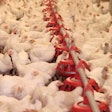One of the major problems identified in the aftermath of the highly pathogenic avian influenza outbreak in the U.S. in 2015 was some significant delays from the time that turkey and layer flocks were confirmed to be infected to when depopulation of these flocks was completed. The U.S. Department of Agriculture (USDA) Animal and Plant Health Inspection Service (APHIS) has stated that, if possible, an infected flock should be put down within 24 hours after confirmation.
Quick depopulation stops the shed of virus and does not allow the increase in shed rate of avian flu virus seen in the outbreaks where flocks remained alive. During the avian flu outbreaks of 2015, the large number of farms that were infected at one time overwhelmed the available resources for depopulating flocks on a timely basis using the approved methods of carbon dioxide carts for layers in cages or fire-fighting foam for floor-raised layers, turkey breeders and turkey meat birds. In some cases, it took as long as two weeks for flocks to be put down. An individual building with cage-housed layers can take as longs as 10 long days to depopulate using carbon dioxide carts.
Some believe many flocks could have been spared infection from highly pathogenic avian influenza in the 2015 outbreaks if all the infected flocks been put down in a timely manner. Because of this, USDA APHIS announced its position on the use of ventilation shutdown on September 18, 2015, as an alternative means of mass depopulation. APHIS' document contains a decision tree for determining whether a particular depopulation situation merits the use ventilation shutdown.
What is ventilation shutdown?
Ventilation shutdown is defined as the cessation of natural or mechanical ventilation of atmospheric air in a building where birds are housed, with or without action to increase the ambient temperature. The cause of bird death is hyperthermia.
The goal is for the house temperature to exceed 104F within 30 minutes and to hold the temperature for three hours. Achieving a relative humidity of 75 percent or higher is also desired. Water for the birds to drink is not turned off and circulation fans within the house maybe used to help equilibrate the temperature throughout the house.
Indiana avian flu outbreak
The U.S. poultry industry didn’t have to wait long to test the USDA’s decision tree for ventilation shutdown. On January 15, 2016, a farm with more than 60,000 tom turkeys in Indiana was confirmed to be infected with a highly pathogenic H7N8 strain of avian flu. Within days, nine other turkey farms were determined to be suspect for avian flu and were tested. These farms were all determined to be infected with a low-path strain of H7N8 avian flu.
Dr. John Clifford, USDA chief veterinary officer, said: “It appears that there was a low-pathogenic virus circulating in the poultry population in this area, and that virus likely mutated into a highly pathogenic virus in one flock.”
There are 124 commercial poultry farms within a 20 kilometer radius of the index site in the Indiana outbreak, according to Denise Derrer, public information director, Indiana State Board of Animal Health. She said that, because of the close proximity of other farms, and the fact that nine other turkey farms tested positive for avian influenza, ventilation was restricted in the poultry houses on all the farms after testing positive.
Eight of the turkey farms and one layer flock were euthanized using foam. Derrer reported that, because of cold temperatures, the foamers didn’t work on two of the turkey farms. Ventilation shutdown was employed so that these two turkey farms could be depopulated without delay.

Mass depopulation of large layer houses cannot be completed in 24 hours using currently recognized-as-humane methods.
As of mid-February, there have been no subsequent findings of avian flu.
The case for ventilation shutdown
Dr. Eric Gingerich, technical service specialist, Diamond V, addressed the committee on transmissible diseases of poultry and other avian species at the United States Animal Health Association’s 2015 annual meeting in Providence, Rhode Island, in October on the topic of ventilation shutdown. He said there are other reasons for deciding to use ventilation shutdown besides the reduction in shedding of virus. Ventilation shutdown also greatly reduces the time of exposure of the workers depopulating flocks using standard methods to possible zoonotic agents, and it reduces the amount of birds suffering from the disease during slower depopulation methods, he reported.
Gingerich said: “It is agreed that ventilation shutdown is not the ideal method for mass depopulation as it results in longer periods of time for suffering compared to other methods. The decision to use ventilation shutdown is only to be made after all other more humane methods have been considered and it has been determined that the time taken for other methods will allow the amount of virus to become excessively high and results in undue spread of the disease.”
The American Association of Avian Pathologists, at its annual meeting in summer 2015, approved a position statement drafted by its animal welfare and management committee to approve the use of ventilation shutdown, with appropriate veterinary consultation, in cases of emergency when deemed necessary in order to control the spread of a foreign animal disease, such as avian influenza.
Ventilation shutdown not humane
While the use of ventilation shutdown as a mass depopulation method of last resort has now been approved, it is important to remember that it is still not considered to be humane. Research needs to continue to develop new options for mass depopulation which are humane and can be implemented quickly for cage- or aviary-housed birds.
Foam only came into use in the U.S. for mass depopulation in the past 20 years, and it works well in most cases with floor-housed birds, but high-cage and aviary systems present a significant challenge.
Ultimately, improved biosecurity on poultry farms, feed mills, hatcheries and processing facilities is the industry’s best protection from disease outbreaks. But even if the outbreak of foreign animal disease are kept low, the industry still needs to develop new humane means of mass depopulation. Ventilation shutdown is effective and may be used when necessary, but it is up to the poultry industry to strive to make it rarely used.
















